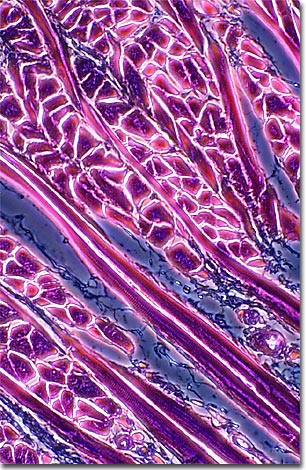Phase Contrast Image Gallery
Human Tongue
A stained thin section of human tongue tissue is illustrated in the photomicrograph presented below. As evidenced by the micrograph, combining phase contrast microscopy with classical histological staining techniques in pathological research often yields enhancement of cellular features.

The primary function of the tongue in mammals is to provide a mechanism for taste. As a muscle it is also important as a means of creating the negative pressure necessary for infants to suckle, an exclusively mammalian activity. The tongue also functions as an accessory organ for chewing, swallowing, grooming and cleaning (producing antibiotics that protect the mouth and open wounds an animal might clean with its tongue). In humans, the tongue is extremely important because it enables spoken language.
This organ is a mass of interwoven, striated muscle tissue interspersed with glands and fat and covered with a mucous membrane. The top surface contains numerous projections of the mucous membrane called papillae, which contain taste buds. Taste is one of two major forms of chemoreception that are part of the human experience, the other being smell. Taste buds are located in different areas of the tongue but are generally found around the edges. They are sensitive to five main tastes: bitter, sour, salty, sweet, and umami (the taste associated with mono-sodium glutamate, or MSG).
One group of scientists has developed an artificial tongue, combining microelectromechanical systems (MEMS) with silicon chips to create an electronic sensor that can identify sweet, sour, salt and bitter components of a substance and even identify the specific chemical elements. Current ambitions are to use the artificial tongue for industrial uses that range from screening new foods for "good taste" to testing blood samples for dangerous chemicals.
BACK TO THE PHASE CONTRAST GALLERY
